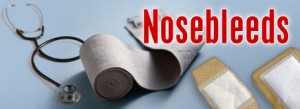 If you’ve ever had a nosebleed before, you know that it usually looks much worse than it actually is. The human nose has many blood vessels that are fragile and bleed easily as a result of trauma and irritation, so it’s actually not hard to experience a nosebleed. Because one of the main reasons nosebleeds happen is due to dry climates, this is especially relevant in the cold winter months as we crank up our central heating systems to stay toasty.
If you’ve ever had a nosebleed before, you know that it usually looks much worse than it actually is. The human nose has many blood vessels that are fragile and bleed easily as a result of trauma and irritation, so it’s actually not hard to experience a nosebleed. Because one of the main reasons nosebleeds happen is due to dry climates, this is especially relevant in the cold winter months as we crank up our central heating systems to stay toasty.
What causes nose bleeds?
Nosebleeds, sometimes referred to as epistaxis, usually happen for one of two reasons: dryness in the environment or irritation from nose picking. Other potential causes include things like: allergies, trauma or force to the outside of the nose, and irritation from chemicals or foreign objects in the nose. It is rare but possible for nosebleeds to be caused by an underlying disease, like liver disease. Nosebleeds are categorized by where the bleeding is coming from: anterior nosebleeds happen when the bleeding comes from the front of the nose, and posterior nosebleeds refer to bleeds from the back of the nose. Anterior nosebleeds are much more common and less serious than posterior nosebleeds; in a posterior nosebleed, you can bleed down the back of your throat and you should see a doctor immediately for treatment.
How should you treat a nose bleed?
If you are actively experiencing a nosebleed, the first thing to do is stay calm. Realize that your nosebleed is likely nothing serious and you can resolve it with a few simple steps. With that said, if you are bleeding as the result of a trauma or there are other factors involved like a blood clotting disorder or feelings of dizziness, you do need to see your doctor instead of attempting to treat the bleed at home. However, for the vast majority of nosebleeds, at-home treatment will resolve the bleed.
You may want to gently blow your nose to rid the nostrils of any clots that are present. Lean forward and pinch your nose shut between your thumb and pointer finger. Although most nosebleeds happen from only one nostril, pinch both sides shut. Breathe through your mouth. Remain in this position for at least 5 – and ideally 10 – minutes. You can repeat this sequence once more if necessary, but if your nosebleed doesn’t clear up after 20 minutes, consider seeking medical treatment.
If your nosebleed does successfully resolve at home, try to avoid the cause of the nosebleed for the rest of the day. For example, if you were picking at the inside of your nose and it started bleeding, don’t touch it again. If you lay down, make sure your head is slightly elevated to prevent any blood from going down the back of your throat.
As we enter the winter season, consider using a humidifier in your home to increase moisture in the air. You can also use a lubricant or ointment like Vaseline to coat the inside of your nose to prevent cracking and bleeding. And again, while most nosebleeds can be treated safely at home, if you have chronic bleeds or are bleeding from other areas of the body, or if you have accompanying symptoms like vomiting and confusion, make an appointment to be seen by your doctor to make sure nothing else is going on. Your doctor may choose to employ medical interventions like packing the nose or cauterizing the vessel to stop bleeding.
